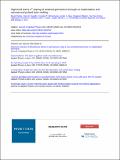High level active n + doping of strained germanium through co-implantation and nanosecond pulsed laser melting
Author(s)
Pastor, David; Gandhi, Hemi H; Monmeyran, Corentin P; Akey, Austin J; Milazzo, Ruggero; Cai, Yan; Napolitani, Enrico; Gwilliam, Russell M; Crowe, Iain F; Michel, Jurgen; Kimerling, LC; Agarwal, Anuradha; Mazur, Eric; Aziz, Michael J; ... Show more Show less
DownloadPublished version (750.0Kb)
Terms of use
Metadata
Show full item recordAbstract
© 2018 Author(s). Obtaining high level active n+ carrier concentrations in germanium (Ge) has been a significant challenge for further development of Ge devices. By ion implanting phosphorus (P) and fluorine (F) into Ge and restoring crystallinity using Nd:YAG nanosecond pulsed laser melting (PLM), we demonstrate 1020 cm-3 n+ carrier concentration in tensile-strained epitaxial germanium-on-silicon. Scanning electron microscopy shows that after laser treatment, samples implanted with P have an ablated surface, whereas P + F co-implanted samples have good crystallinity and a smooth surface topography. We characterize P and F concentration depth profiles using secondary ion mass spectrometry and spreading resistance profiling. The peak carrier concentration, 1020 cm-3 at 80 nm below the surface, coincides with the peak F concentration, illustrating the key role of F in increasing donor activation. Cross-sectional transmission electron microscopy of the co-implanted sample shows that the Ge epilayer region damaged during implantation is a single crystal after PLM. High-resolution X-ray diffraction and Raman spectroscopy measurements both indicate that the as-grown epitaxial layer strain is preserved after PLM. These results demonstrate that co-implantation and PLM can achieve the combination of n+ carrier concentration and strain in Ge epilayers necessary for next-generation, high-performance Ge-on-Si devices.
Date issued
2018Department
Massachusetts Institute of Technology. Department of Materials Science and Engineering; MIT Materials Research LaboratoryJournal
Journal of Applied Physics
Publisher
AIP Publishing